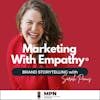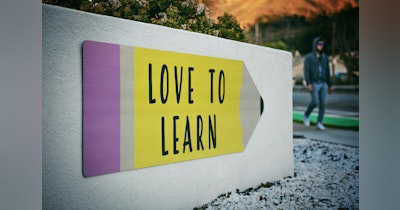What role does empathy play in your brand storytelling plans? Does it actually help drive stronger results, or is it just perceived as upper-funnel fluff and a nice to have to round out your brand’s content plans?
On today’s episode, I tackle some misconceptions about empathy, discuss why I find it important enough to name my podcast Marketing With Empathy -- and if I do my job right-- hopefully add a new marketing term to your daily vocabulary.
WHAT ARE EXAMPLES OF NOSTALGIA MARKETING
As a kid I LOVED watching Full House, Karate Kid and any Disney movie I could. So, it shouldn’t come as a shocker that decades later the remakes of these shows are something I also want to watch, and I want to share with my kids.
These shows are tapping into what’s called Nostalgia Marketing. It’s ONE form of how you can use empathy to connect with your audience. During times of crisis or discomfort, nostalgia can provide a comforting familiar feeling for your audience. Think of nostalgia like comfort food. So, it’s no surprise that during COVID-19, many of us are excited to watch these show remakes. It comforts us.
For example, Liftmaster garage doors recently tapped into nostalgia marketing by creating a video spot that recreates an iconic scene from Ferris Bueller’s Day off. It’s the scene where Cameron- the nervous teen who reluctantly takes his dad’s sweet red convertible for a joy ride after Ferris peer pressures him into it. Liftmaster recreated the entire garage scene down to the minute details, but this time the actor who played Cameron in the original Ferris Bueller is now the DAD. and now when his son tries to take the convertible out of the garage, the new Liftmaster Secure View Opener garage door has a surveillance camera that streams footage to dad’s smartphone. The kid’s busted… his dad talks to him through the smart garage opener and he’s not taking the car anywhere.
It’s a playful spot that helps you remember the benefit of having video surveillance on your garage door opener. If this was just a video spot talking about the features and benefits of the smart garage door opener, it would be less memorable. I sure wouldn’t be talking about it. But, by tapping into an empathy-filter moment, Liftmaster was able to create a video with more sticking power.
LIftmaster Garage Commercial: Ferris Bueller's Day Off remake and example of nostalgia marketing WATCH
WHAT IS EMPATHY MARKETING?
Let’s talk more about EMPATHY overall—because nostalgia is just one small piece of the bigger opportunity here.
Empathy is all about connecting heart to heart or mind to mind. At it’s core, empathy is about truly understanding your target audience and speaking to them in a way to makes them feel heard; gets them to stop and pay attention to your brand, and drives them to action. Empathy is the ability to understand and share the feelings of another. As brand storytellers we’re trying to get people to stop and read/watch/listen to our content. We’re trying to educate, entertain or inspire. We’re supporting larger business objectives through the stories we’re telling.

MISCONCEPTIONS ABOUT EMPATHY MARKETING
One misconception about empathy is that it’s all fluffy heart-felt feel good stuff. That it doesn’t actually drive biz results. That empathy means you need to make your audience laugh or cry. And, while empathy can definitely be these things, it’s SOOO much more. In my nearly two decades of experience driving content for billion-dollar brands, and proving brand storytelling as a leading ROI generator-- what I’ve seen first-hand is that empathy drives stronger business results. Period.
WHAT IS AN EMPATHY-FILTER AND HOW CAN IT HELP MY BRAND STORYTELLING EFFORTS?
If you want to lean in more to use empathy to improve your content’s performance, I have some tips to get you started.
First: let’s give is a name. I call it your Empathy filter. This is a phrase I made up that I hope you’ll add to your vocabulary after today.
Your Empathy filter is ultimately a question of why will your audience care about this piece of content? What's the empathy filter? This is always a question I ask with every piece of branded content.
To operationalize it and ensure it’s top of mind for you and your team, I recommend adding it as a column in your content calendar. Add it as a section of your creative briefs. If you don’t have a good reason for how this piece of content is going to speak to your audiences heart or mind—revise it until you do. If you do nothing else after this podcast, just add the two words “Empathy-filter” to whatever document you use to plan your content and bring up the next time you’re looking at your plans.
HOW TO USE SEO FOR EMPATHY INSIGHTS
I think SEO provides an incredible insight into the questions and thoughts of your audience. When you can look and see what questions people are typing into google related to your industry, What things they’re trying to understand better…. That’s a gold mine for you. SEO is my absolute FAVORITE research tool to help identify empathy-filter angles. When in doubt, start with SEO.
When using SEO to strategically map out your content plans, your answer to the Q “what’s the empathy filter” could be—to answer people’s confusion about xxx. To save people time by comparing y and z for them because you see a lot of search volume around those two topics that relate to your industry. OR- validating emotions they’re feeling about a topic.
EXAMPLES OF EMPATHY
These empathy-filter moments help your audience remember and connect:
- Where you think about the emotions or life moments
- Burning desires or goals
- Shared passions and interests
- Things they wish for
- Putting yourself in the target audience's shoes
- Stress they feel as a parent
- How happy they feel when >fill in the blank<
- The last or first time they ________
- It's even just as simple as connecting on shared experiences you know they’ve had: like being on virtual meetings, having a terrible sort throat, when you were so nervous to present to a group of people, when you sat in your car until the song was done because it was such a great song.
TO RECAP...
Yes, empathy drives stronger biz results and ROI
No, empathy isn’t just upper-funnel fluff
Yes, there are lots of different ways you can think about connecting with your audiences hearts and minds.
And, yes- you should absolutely add an “empathy-filter” to your content planning docs right away.
I hope this was useful for you.
Take a screenshot of you tuning in to this episode and share it and tag me on Instagram at @iamsarahpanus. I’d love to hear your thoughts and connect.
AFFORDABLE BRAND STORYTELLING FRAMEWORK POWERPOINT TEMPLATE

A more focused and aligned brand storytelling marketing strategy is right around the corner! If you’re looking for a quick brand storytelling framework template to plug and play, I’ve got your back. I created this affordable PowerPoint template, with the above five essentials, to help you easily and quickly create your own brand storytelling framework. All you have to do is follow the prompts, update with your brand’s info, and bam—you have your own brand storytelling framework to follow and use for team alignment. LEARN MORE
LINKS MENTIONED IN EPISODE
- Fuller House on Netflix
- Cobra Kai on Netflix
- LIftmaster Garage Commercial: Ferris Bueller's Day Off remake and example of nostalgia marketing WATCH
ABOUT THE AUTHOR
Sarah Panus is a brand storytelling marketing strategist, podcast host, Minnesota mom, and owner of Kindred Speak, LLC, a remote consultancy that helps corporations attract upper-funnel leads that drive bottom-funnel results through storytelling. Her mission is to add value to the world by humanizing brand+consumer connections. Her online courses teach content professionals inside corporations how to think like Editorial Directors to drive stronger results while enjoying their jobs more. She’s spent the last 20 years helping brands including Sleep Number, Starbucks, Nestle Waters, Christos Bridal, Game Crazy, Cone Inc, and others, speak a kindred language with their audiences, driving brand advocacy and millions in revenue and brand engagements. Learn more at www.kindredspeak.com.







